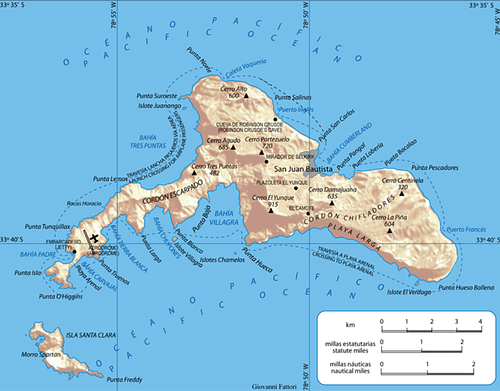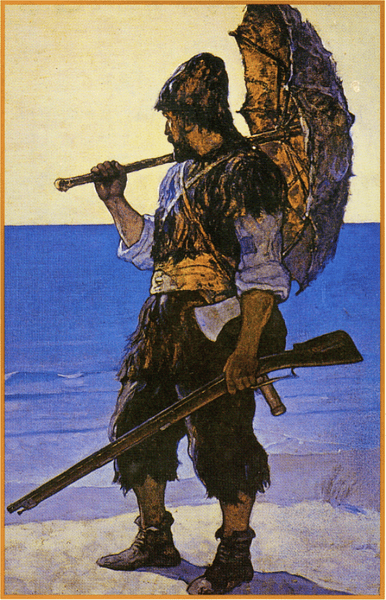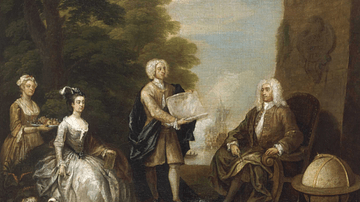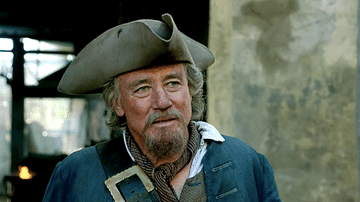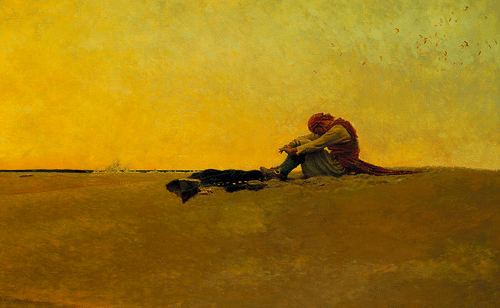
Alexander Selkirk (or Selcraig, 1676-1721) was a Scotsman famously marooned for four years and four months on a desert island in the Pacific Ocean until his rescue by a passing British ship in February 1709. His story inspired the title character of the acclaimed 1719 novel Robinson Crusoe by Daniel Defoe (c. 1660-1731).
Selkirk was on a privateering expedition in the Pacific when he was marooned on the remote Juan Fernández Islands. He might have suffered over four years of solitude but he fared better than his shipmates who were subsequently shipwrecked and taken to a Spanish prison. Selkirk’s fortunes improved remarkably following the capture of a Spanish treasure ship by the expedition that had rescued him. Living well off his share of the booty in England, Selkirk became an officer in the Royal Navy before dying at sea in 1721.
Early Life
Alexander Selkirk, sometimes given as Selcraig, was born in Scotland in 1676. He was the son of a shoemaker and had six brothers. His first appearance in the historical records is that he was found guilty of indecent behaviour, of all places, in church. He then went to sea and became officer material thanks to his skill in mathematics and using navigational instruments. In 1703, he joined the fateful privateering expedition of William Dampier (c. 1651-1715), destined for adventure in the Pacific Ocean.
Marooned
To be marooned on a desert island was not an uncommon punishment for unruly sailors, but in 1704, Selkirk volunteered for the treatment mid-expedition. Typically, a mariner was left without provisions, equipment, or even clothes so that marooning was, in reality, a delayed death sentence and a punishment reserved for thieves and mutineers. For this reason, some sailors preferred to be shot outright, and for those who did not, they were often left with a pistol anyway so that they might use it on themselves when the ravages of thirst and starvation raged to their peak.
The whole disastrous episode began some time earlier. Sailing in the Pacific Ocean off the coast of Chile in the summer of 1704, the British privateering expedition led by William Dampier reached the Juan Fernández Islands, 630 km from the coast. There were two ships in the expedition, the Saint George, captained by Dampier, and the Cinque Ports, captained by Thomas Stradling. The original captain of Cinque Ports had died mid-voyage and so Stradling was promoted while Selkirk was made master, second-in-command. This was, perhaps, the beginning of the friction between the two mariners. Stradling proved to be a less-than-talented commander, and his strict discipline did not endear him to his crew. Indeed, there was a near-mutiny at one point, but Dampier stepped in and resolved the situation. Tensions slowly rose again following a spell where few prizes were captured, and an attack on the fortified Spanish port of Santa Maria in Panama was unsuccessful.
The Cinque Ports was by now badly in need of repairs and so the ship separated from the Saint George and stopped at the Juan Fernández Islands in September. Selkirk argued with Stradling that the new caulking was insufficient on the ship and it would very likely leak so badly that the ship would sink. Selkirk refused to sail, and Stradling left him on the island with his sea chest in October. Fortunately for Selkirk, his chest contained a great number of useful pieces of equipment for life on an uninhabited island. These were listed by his rescuer as:
He had with him his clothes and bedding, with a fire-lock [musket], some powder, bullets and tobacco, a hatchet, a knife, a kettle, a Bible, some practical pieces, and his mathematical instruments and books. He diverted and provided for himself as well as he could; but for the first eight months had had much ado to bear up against melancholy and the terror of being left alone in such a desolate place.
(Rogers, 92)
In the tropical climate, Selkirk’s clothes soon disintegrated and so he made new ones using goat skins sewn together with a needle he had fashioned from a nail. By rubbing sticks of pimento wood together, he was able to make his own fire. He built two shelters from branches and long grass and furnished these with more goatskins. He tamed a large number of the island’s wild cats to keep his shelter free from rats and to give himself something to fill the long lonely days. His faith ensured he kept his sanity as he read through his Bible and sang hymns. His rescuer Rogers reported that Selkirk had "said he was a better Christian while in this solitude than ever he was before, or than, he was afraid, he should ever be again" (Ibid).
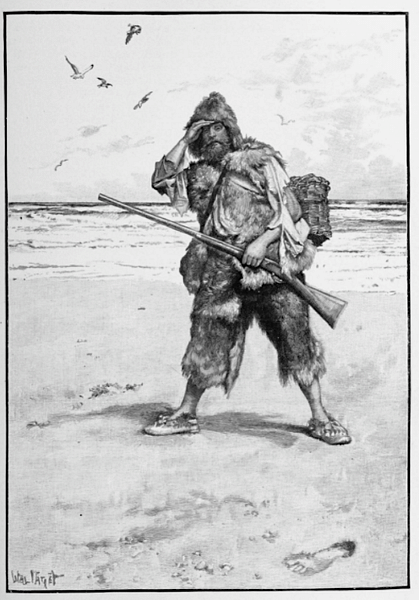
Selkirk’s island, known today in Spanish as Isla Robinson Crusoe (formerly Isla Más a Tierra), is crescent-shaped with a long thin peninsula at the western end and mountains in the centre. Heavily forested, the island provided Selkirk with timber, fresh spring water, and meat from goats, seals, and sea lions. There were, too, wild plums and herbs, and turnips that had been planted by mariners on previous sojourns on the islands. According to Rogers, Selkirk could not abide fish without salt, since it affected his bowels badly, but he did eat lobsters when he could catch them. The island group had been used as a pirate and privateering base throughout the 17th century, and Selkirk likely thought the chances of a passing vessel coming to rescue him within a couple of months were quite high. As it turned out, he had to wait over four long years to see another human being again. At least, had he had means, Selkirk would have been satisfied to hear that he was right about the Cinque Ports, and it did indeed sink, shipwrecking Stradling and a number of the crew on the Mapella Islands. There they stayed until a Spanish ship picked them up and transported them in chains to a prison in Lima on a charge of piracy. Selkirk had clearly enjoyed the better fate of the two men.
The Miskito William
Curiously, Selkirk was not the first mariner to be marooned on the Juan Fernández Islands. In 1681, the buccaneer Captain Watling left there by necessity a Mosquito Indian (aka Miskito, from Honduras or Nicaragua). Watling’s ship was threatened by an approaching Spanish vessel and so he left the island while this man, called William, had been out hunting for fresh meat. William was not forgotten by some of Watling’s crew who sailed past the islands in 1684 under another buccaneer, Captain John Cook. One crew member was William Dampier (him again), and he wanted to see if William was still alive on the desert island. He found his old shipmate in good health, although his clothes had been replaced with goatskins. William had survived thanks to his rifle which, although useless as a firearm when he had run out of bullets, had been tremendously useful when William cut up the metal barrel to make various tools like fishhooks.
Rescue & Riches
Alexander Selkirk had settled down to life on his island, but he kept a constant watch for passing ships. Finally, one ship landed. Back in 1708, the Englishman Woodes Rogers (1679-1732) had embarked on a privateering voyage that would ultimately take him around the world. On 2 February 1709, mid-circumnavigation, Rogers rescued Selkirk from the Juan Fernández Islands. Rogers recorded some details of Selkirk’s lonely life on his desert island in his own memoirs of the circumnavigation as presented in A Cruising Voyage Round the World, published in 1712. Rogers noted that Selkirk was "clothed in goat skins" and that he "looked wilder than the first owners of them" (Ibid). He also recorded that Selkirk had forgotten how to speak but was, otherwise, in tip-top physical condition. When he regained his speech, Selkirk told Rogers that he had sighted only a few ships over the years and that none had seen his signal fires. Two ships had anchored at the islands, but these were Spanish and had shot at Selkirk, requiring him to retreat into the forest.
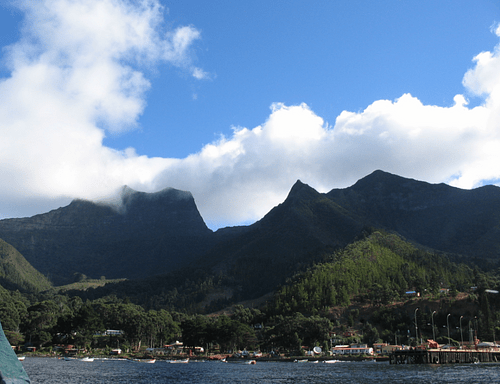
Apparently, when Selkirk caught sight of William Dampier (yes, he was on this voyage as well), who was Rogers’ chief navigator, he asked to be put ashore and left to his solitude, but Rogers refused. Dampier, despite this cold attitude, recommended that with his maritime experience and navigational know-how, Selkirk would be a useful addition to the crew. As a consequence, Selkirk was made the second mate on board Rogers’ ship the Duke.
The privateering expedition continued and soon made a remarkable capture, the prize ship Nuestra Señora de la Encarnación Disengaño, a Manila galleon, which carried a huge quantity of Chinese and other precious goods. Taken on New Year’s Day 1710, this was an astonishing coup since only four Manila galleons were ever taken across three centuries of opportunity, so well-armed and protected were these annual Spanish treasure ships that ferried loot between Acapulco in Mexico and Manila in the Philippines. Selkirk was given an £800 share of the booty from the galleon (over £150,000 or $200,000 today) and so his was a real rags-to-riches story. Following his return to England in October 1711 after what had been an eight-year absence from his homeland, Selkirk lived comfortably off his prize money for several years, and in 1717, he became an officer in the Royal Navy; he died at sea in 1721 after contracting a tropical fever. He was reported as saying in these later years that he always wished he was back on his desert island.
Selkirk & Robinson Crusoe
Selkirk's life on a desert island inspired Daniel Defoe’s novel Robinson Crusoe, first published in 1719 and widely considered the first novel in the English language. Defoe took a great interest in maritime history and particularly the lives of privateers and pirates. Indeed, he is credited by some historians as the man behind the celebrated pirate’s who’s who A General History of the Robberies and Murders of the Most Notorious Pyrates. The work was compiled in the 1720s, and its title page credits the author as Captain Charles Johnson. Johnson and Defoe may have been one and the same. Although there is scant evidence that Defoe ever met Selkirk, the author is known to have met Woodes Rogers and so he would have heard of Selkirk’s story firsthand from his rescuer. There was, too, an interview with Selkirk made and published in 1713 by the journalist Sir Richard Steel (1672-1729). Defoe would also have known about William, left on the island in 1681 as William Dampier recounted that story in his various memoirs published in 1697 and 1699. William was perhaps the inspiration for the Friday character, a cannibal who Crusoe rescues.
There are some notable differences between Crusoe and Selkirk, with the former being shipwrecked, not deliberately marooned, and then ending up on a desert island off the east coast of South America, not the west coast. Crusoe survives 27 years and ultimately finds a companion in Friday, which Selkirk never did in his four years and four months of solitude. Whether one takes Robinson Crusoe as an entertaining account of survival or an allegory for spiritual redemption, a significant contribution to the success of the novel is the convincing level of detail. Defoe has expertly woven maritime details taken from such old sea-salts as Rogers and Dampier into the framework of Selkirk’s story and created an entirely believable account of human survival. The book was an instant classic and has become one of those rare novels that is as much loved by literary critics as by general readers.
The enduring appeal of Robinson Crusoe has ensured that historians remain keen to investigate the life and times of Alexander Selkirk. An archaeological expedition was sent to the Juan Fernández Islands in 2005 and tasked with discovering any artefacts related to the Selkirk story. The rather meagre findings included a fragment of a pair of metal navigational dividers, almost certainly Selkirk’s. As a final note, Selkirk did, perhaps, write a diary of his experience, but this, like its author once was, has become marooned, forgotten in the State Library of Prussian Cultural Heritage in Berlin where even its very existence is disputed.
